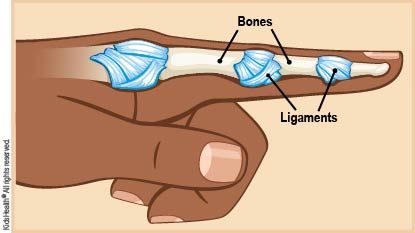Jammed Finger: How to Care for Your Child
Most kids who jam a finger can gradually return to their normal activities. The finger might feel sore or stiff for a while.


The finger joints (commonly called knuckles) are where two bones connect so the fingers can bend. A jammed finger is an injury to a finger joint. It can happen when a ball or other object hits the end of a straightened finger. Ligaments (bands of tissue connecting the bones) may stretch, tear, or break. Sometimes there can be small breaks in the bones.
The health care provider asked you and your child questions and did an examination. Your child had X-rays that showed no broken bones. To help it heal, the health care provider put a splint on the injured finger or taped it to the neighboring finger ("buddy taping").
Depending on the type of injury, your child will have a splint or taped fingers for a few days to a few weeks. The health care provider also may recommend gentle hand exercises to strengthen the finger and reduce joint stiffness.

-
Give your child pain medicine as directed:
-
If the health care provider has NOT prescribed a pain reliever, you may give acetaminophen OR ibuprofen, if recommended.
-
If the health care provider prescribed a pain reliever, ask the health care provider or pharmacist before using acetaminophen or ibuprofen. Some prescription pain medicines contain acetaminophen. Using two medications that contain acetaminophen could cause your child to get too much.
-
For the next few days:
-
Put a cold pack or plastic bag of ice wrapped in a towel on the finger for 20 minutes three or four times a day. Do not place ice directly on the skin.
-
To keep swelling down, help your child prop the hand on pillows above heart level as much as possible when sitting down or sleeping.
-
If your health care provider recommended hand or finger exercises, your child should do them as instructed.
-
If your child has a splint, follow your health care provider's instructions for taking care of it. Do not try to remove or adjust it unless your health care provider tells you to.
-
If your child has a buddy taping, change it each day or anytime it gets wet or dirty as the health care provider or nurse showed you. Your child can use hand sanitizer to clean hands, but when the hands are visibly dirty, your child should remove the tape, wash hands in soap and water, and replace the tape.

-
Schedule a follow-up appointment as directed.
-
Ask your health care provider when it's OK for your child to return to sports. The health care provider may recommend protective hand gear or taping for sports.

-
Pain doesn't improve with medication.
-
Swelling doesn't go down with propping the hand up.
-
The finger looks red or feels warm.
-
Your child can't move the finger normally after the swelling goes down.
